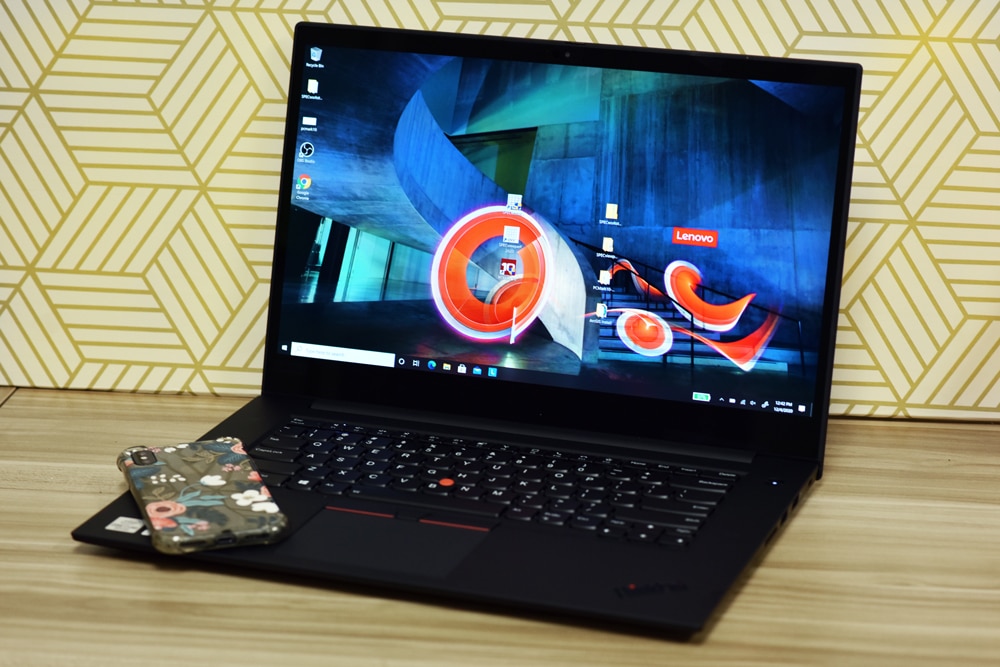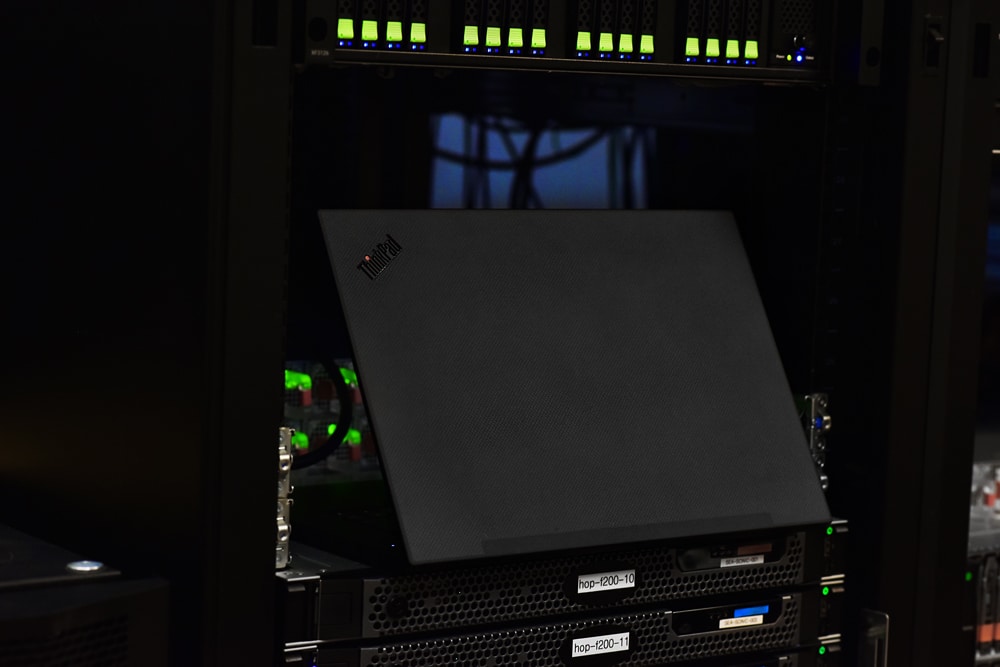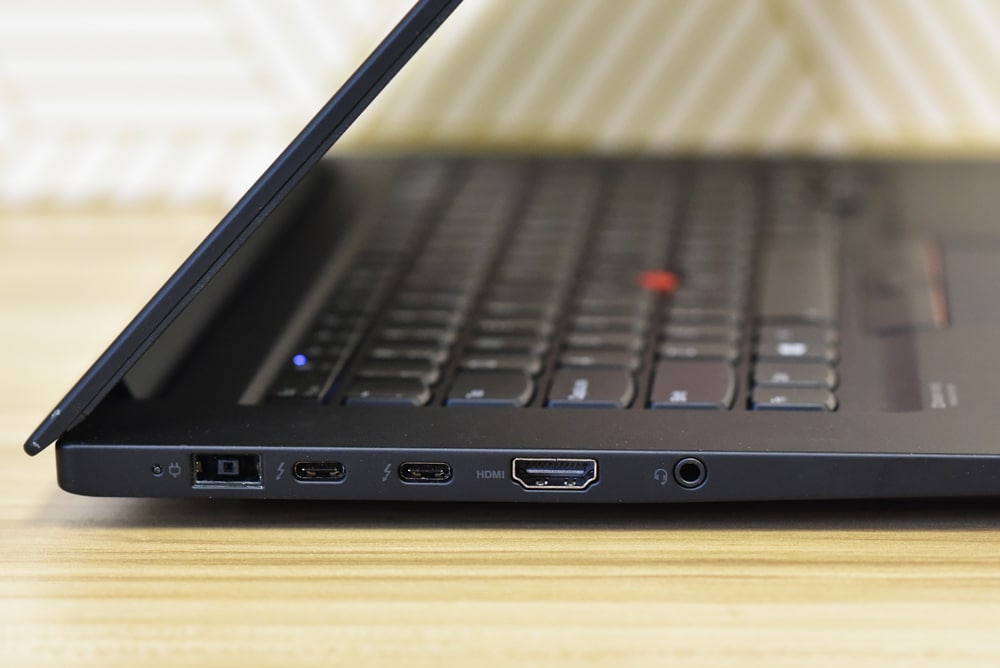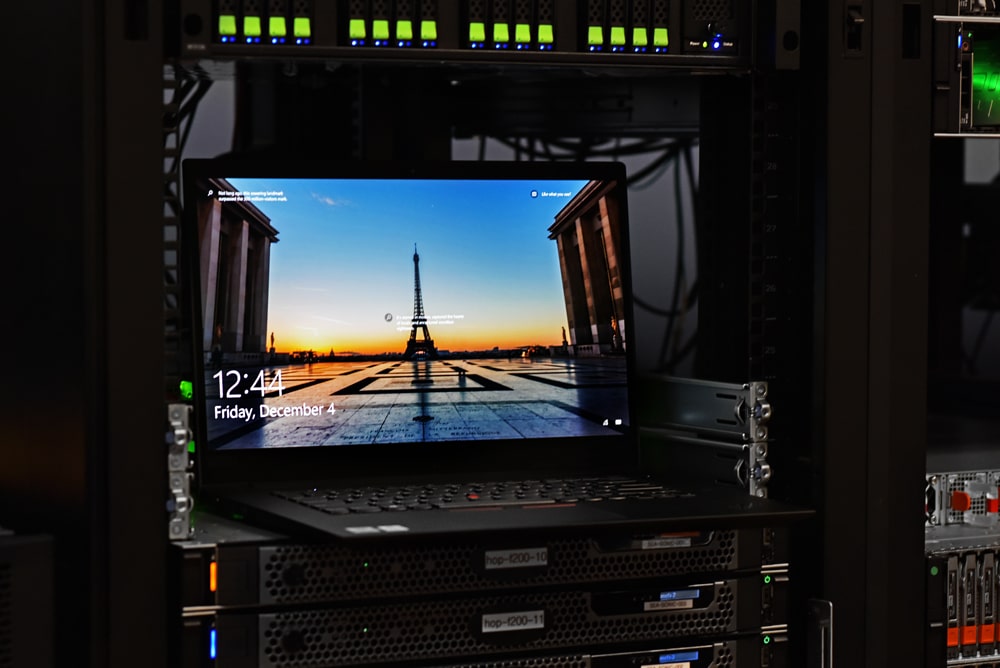The Lenovo ThinkPad P1 Gen 3 is the newest from the company’s popular line of mobile workstations. Lenovo built this laptop as an affordable option specifically for entry to midrange technical users and to tackle professional use cases, such as in architecture, design, healthcare, and entertainment media. It’s also specced for prosumers just looking for a speedy laptop for their computing needs. Though it is considered an entry-level system, the P1 Gen 3 features some pretty hefty component combination possibilities like the 10th Gen Intel Core H series or Intel Xeon processors and NVIDIA Quadro professional graphics.
The Lenovo ThinkPad P1 Gen 3 is the newest from the company’s popular line of mobile workstations. Lenovo built this laptop as an affordable option specifically for entry to midrange technical users and to tackle professional use cases, such as in architecture, design, healthcare, and entertainment media. It’s also specced for prosumers just looking for a speedy laptop for their computing needs. Though it is considered an entry-level system, the P1 Gen 3 features some pretty hefty component combination possibilities like the 10th Gen Intel Core H series or Intel Xeon processors and NVIDIA Quadro professional graphics.

We previously reviewed the ThinkPad P1 Gen 2 model last year. At first glance, not much has seemed to change, as it features the same connectivity ports, potential drive performance/capacity, graphics card options, and general weight range. The Lenovo ThinkPad P1 Gen 3 is also as customizable as its predecessor. However, the Gen 3 model can now be outfitted with the newest generation of Intel processors, including an Intel Core i7-10750H (6-core, 2.6GHz-5.0GHz 12MB cache) all the way up to an Intel Xeon W-10855M (6-core, 2.8GHz-5.1GHz, 12MB cache). It also now features an optional SIM tray, so users can leverage their mobile data to connect to the Internet, rather than requiring a wireless router. This certainly opens up a whole new level of convenience and mobility.
Users also can equip the P1 Gen 3 with 8GB to 32GB of DDR4-3200 (non-ECC) or DDR4-2933 (ECC) RAM on each of its (2) DIM slots for a max total of 64GB and have the choice of adding up to two M.2 PCIe NVMe SSDs in capacities of 256GB, 512GB, 1TB, or 2TB.
The P1 features several display options as well, including those with Dolby Vision HDR. You can go the more affordable route with an FHD (1920×1080) screen at 700:1 for contrast ratio, or open up your wallet a bit more for the ultra-high-definition (3840×2160) Dolby Vision model, which features HDR 500 True Black touchscreen panel with color calibration and a 100000:1 contrast ratio. The 4K version also has a wide-angle LED option (178 degrees versus 170 degrees). All models come with a custom-designed Dolby Atmos speaker system, which sounded pretty crisp and clear good during our tests.

For connectivity, the P1 Gen 3 comes with two Thunderbolt ports (USB-C form, Thunderbolt 3, USB 3.2 Gen 2, PD, DP), two USB-A 3.2 Gen 1 (one Always-on) ports, an HDMI 2.0 port, and the standard headphone/microphone combo jack. It also is equipped with the usual SD card reader and security keyhole in case you need to fasten it to a workstation area.
Our review model is more in line with a mid-range build, including an Intel Core i7-10850H (2.7 Ghz), 32GB of DDR4 3200 RAM, a 1TB Samsung PM981a NVMe SSD (with quoted speeds of 3.5GB/s in reads and 3GB/s in writes), a Quadro T2000 professional graphics card, an OLED 15.5″ (3840×2160) display, and Windows 10 Pro for the operation system. This build came in at just over $3,100 USD. Those looking for the most premium build will have to spend almost $5K.
Lenovo ThinkPad P1 Gen 3 Specifications
| Processor |
|
| Operating System |
|
| Display |
|
| Memory |
|
| Battery |
|
| Storage |
|
| Graphics |
|
| Security |
|
| Pen | (Optional) ThinkPad Pen Pro with Wacom AES 2.0 Pen support |
| Audio |
|
| Camera |
|
| Dimensions | 0.72” x 14.24” x 9.67” / 18.4mm x 361.8mm x 245.7mm |
| Weight | Starting at 3.75 lbs (1.7 kg) |
| Keyboard |
|
| Colour | Black |
| Connectivity |
|
| Ports / Slots |
|
| ISV Certifications |
|
| Green Certifications |
|
| Additional Features |
|
| Preloaded Software |
|
| What’s in the Box |
|
Lenovo ThinkPad P1 Gen 3 Design and build
The P1 Gen 3 features a durable, lightweight carbon fiber build and is touted by Lenovo as their lightest 15.6″ mobile workstation to date (just like the previous-gen model). This is certainly isn’t surprising, as it weighs in at just 3.75lbs (though depending on your configuration, it could get a bit heavier) and is very easy to carry and maneuver around the office. Overall, a very portable device that can go pretty much anywhere without much effort.

Lenovo also gives users the option to add integrated mobile broadband Nano-SIM tray to their P1 (on the right side), so you don’t even need to be near a wireless hub/modem to get connected. This makes the Gen 3 model even more flexible than it already is.

On the right side of the Lenovo workstation is an SD card reader, a USB-A 3.2 Gen 1 port, a USB-A 3.2 Gen 1 (always on) port, and the usual Kensington lock slot. The left side is home to the power-in port, dual USB-C Thunderbolt 3 ports, the HDMI 2.0 port, and headphone/mic combo jack.

Besides the integrated Intel UHD graphics, Lenovo has included the following professional discrete GPU options for the ThinkPad P1 (Gen 3).
NVIDIA Quadro T2000 Specifications:
- GPU Architecture: NVIDIA Turing
- Single-Precision Performance: Up to 3.5 TFLOPS
- NVIDIA Cuda Cores: 1,024
- Memory Configuration: 4GB GDDR5
- Memory Bandwidth: Up to 128 GB/s
- Display Output Connectors: DisplayPort 1.4
- Board Form Factor and Length: x
- Thermal Solution: Active
- Max Power Consumption: 40 – 60 W
- VR Ready: No
NVIDIA Quadro T1000 Specifications:
- GPU Architecture: NVIDIA Turing
- Single-Precision Performance: Up to 2.6TFLOPS
- NVIDIA Cuda Cores: 768
- Memory Configuration: 4GB GDDR5
- Memory Bandwidth: Up to 128 GB/s
- Display Output Connectors: DisplayPort 1.4
- Board Form Factor and Length: x
- Thermal Solution: Active
- Max Power Consumption: 40 – 50 W
- VR Ready: No
*Please note that there were no product pages for these specific cards on the NVIDIA website, including datasheets. This information was taken from the Quadro mobile line card PDF published back in August 2019.
Lenovo ThinkPad P1 Gen 3 Performance
To see what the Lenovo P1 Gen 3 can do, we put it through a series of resource-intensive tests when outfitted with an Intel Core i7-10850H (2.7 Ghz), 32GB of DDR4 3200 RAM, a 1TB Samsung PM981a NVMe SSD and an NVIDIA Quadro T2000 GPU (4GB GDDR5). Note that we didn’t list performance results of other workstations for comparisons, as we were having a momentous amount of trouble getting the Gen 3 model to properly work with some of the benchmarks, specifically the Specview/wpc and ArcGIS benchmarks. We were getting unexpectedly weak results, even after forcing discrete graphics (disabling the Intel onboard GPU) and changing the resolution, among other things. So you can certainly take these results for what it’s worth.
That being said, first up is PCMark10, a system benchmark for Windows PCs with a focus on modern office tasks. It offers a variety of workloads categorized into three groups. The Essentials group includes web browsing, video conferencing, and app start-up time. The Productivity group includes tests based on spreadsheets and writing. The Digital Content Creation group includes photo editing, video editing, and a rendering and visualization test.
Here, the Lenovo P1 Gen 3 showed solid results for its class (overall score of 5,826), including essentials (10,366), productivity (8,173), and digital content (6,335). The latter score was hindered a bit by the video editing and section (as well as ray tracing) due to the FPS limitations of the graphics card. This was expected, as it is a lower-range model from the Quadro line.
The SPECviewperf 2020 benchmark is the worldwide standard for measuring graphics performance of professional applications running under the OpenGL and Direct X application programming interfaces. The viewsets (or benchmarks) represent graphics content and behavior from actual applications, without having to install the applications themselves. These viewsets include 3D Max, CATIA, Creo, Energy, Maya, Medical, Siemens NX, and Solidworks.
Please note that the Lenovo P1 Gen 3 is one of the few workstations we tested that used this new version of SPECviewperf (the first being the HP z2 mini g5, which we will compare it to). This benchmark went through some major updates on October 14, 2020:
- New viewsets taken from traces of the latest versions of 3ds Max, Catia, Maya, and Solidworks applications.
- Updated models in the viewsets based on 3ds Max, Catia, Creo, Solidworks, and real-world medical applications.
- Support within all viewsets for both 2K and 4K resolution displays.
- User interface improvements, including better interrogation and assessment of underlying hardware, clickable thumbnails of screen grabs, and a new results manager.
- Support for running the benchmark using command-line options.
| SPECviewperf 2020 | ||
| Viewsets | Lenovo ThinkPad P1 Gen 3 (NVIDIA Quadro T2000) |
HP Z2 Mini G5 (NVIDIA Quadro T2000) |
| 3dsmax-07 | 23.91 | 26.65 |
| Catia-06 | 18.82 | 20.3 |
| Creo-03 | 42.84 | 45.39 |
| Energy-03 | 7.12 | 6.23 |
| Maya-06 | 63.29 | 72.11 |
| Medical-03 | 6.91 | 7.31 |
| Snx-04 | 102.58 | 109.76 |
| Sw-05 | 21.83 | 5.08 |
Next, we ran SPECworkstation3, a test that specializes in benchmarks designed for testing all key aspects of workstation performance; it uses over 30 workloads to test CPU, graphics, I/O, and memory bandwidth. The workloads fall into broader categories such as Media and Entertainment, Financial Services, Product Development, Energy, Life Sciences, and General Operations. We are going to list the broad-category results for each, as opposed to the individual workloads. The results are an average of all the individual workloads in each category.
| SPECworkstation3 | |
| Category | ThinkPad P1 Gen 3 Intel Core i7-10850H NVIDIA Quadro T2000 |
| M&E | 1.89 |
| ProdDev | 1.86 |
| LifeSci | 1.51 |
| Energy | 1.03 |
| FSI | 1.28 |
| GeneralOps | 1.94 |
| GPU Compute | 1.74 |
The last of the tests is the Environmental Systems Research Institute (Esri) benchmark. Esri is a supplier of Geographic Information System (GIS) software. Esri’s Performance Team designed their PerfTool add-in scripts to automatically launch the ArcGIS Pro. This application uses a “ZoomToBookmarks” function to browse various predefined bookmarks and create a log file with all the key data points required to predict the user experience. The script automatically loops the bookmarks three times to account for caching (memory and disk cache). In other words, this benchmark simulates heavy graphical use that one might see through Esri’s ArcGIS Pro software.
The tests consist of three main datasets. Two are 3-D city views of Philadelphia, PA and Montreal, QC. These city views contain textured 3-D multipatch buildings draped on a terrain model and draped aerial images. The third dataset is a 2-D map view of the Portland, OR region. This data contains detailed information for roads, land use parcels, parks and schools, rivers, lakes, and hill shaded terrain.
Looking at drawtime of the Montreal model, the Lenovo ThinkPad P1 Gen 3 showed an average drawtime of 00:01:30.292, while average and minimum FPS showed 142.98 and 68.92, respectively.
| ESRI ArcGIS Pro 2.3 Montreal | |
| Drawtime | Average |
| ThinkPad P1 Gen 3 | 00:01:30.292 |
| Average FPS | Average |
| ThinkPad P1 Gen 3 | 142.98 |
| Minimum FPS | Average |
| ThinkPad P1 Gen 3 | 68.92 |
Next up is our Philly model, where the ThinkPad P1 Gen 3 showed an average drawtime of 00:01:00.167, while average and minimum FPS showed 105.37 and 59.39.
| ESRI ArcGIS Pro 2.3 Philly | |
| Drawtime | Average |
| ThinkPad P1 Gen 3 | 00:01:00.167 |
| Average FPS | Average |
| ThinkPad P1 Gen 3 | 105.373 |
| Minimum FPS | Average |
| ThinkPad P1 Gen 3 | 59.39 |
Our last model is of Portland. Here, the P3 had an average drawtime of 00:00:30.504. Average FPS showed 1,895.93 while minimum FPS posted 565.74.
| ESRI ArcGIS Pro 2.3 Portland | |
| Drawtime | Average |
| ThinkPad P1 Gen 3 | 00:00:30.504 |
| Average FPS | Average |
| ThinkPad P1 Gen 3 | 1,895.93 |
| Minimum FPS | Average |
| ThinkPad P1 Gen 3 | 565.74 |
Conclusion
The Lenovo ThinkPad P1 Gen 3 is a solid, entry-level mobile workstation that features one of the lightest builds on the market (at just 3.75lbs), with all the power you need to run your resource-intensive software. This ultra-portable laptop features a 15-inch display that gives users to choose up to a bright and beautiful 4K (3840×2160) resolution with Dolby Vision with an HDR 500 True Black touchscreen panel that has color calibration and a 100000:1 contrast ratio. You can also outfit the mobile workstation with the decent Quadro T2000 GPU, and although it features the Turing architecture, it is not compatible with VR or AI environments.

The ThinkPad P1 Gen 3 also features a comprehensive range of connectivity options, including two Thunderbolt ports (USB-C form, Thunderbolt 3, USB 3.2 Gen 2, PD, DP), two USB-A 3.2 Gen 1 (one Always-on) ports, an HDMI 2.0 port, and the standard headphone/microphone combo jack. It’s also equipped with the usual SD card reader and security keyhole. Like in the previous model, a dongle, extender, hub, or dock is required for an Ethernet connection; however, the Gen 3 model now features a SIM tray (optional add on), so you can use your mobile data to connect to the Internet, making this system very convenient when you’re in an area with no wireless or you don’t have your dongle with you. The battery life is decent as well, as MobileMark 2018 clocks it in at up to 12 hours of use (though that will certainly go down with heavy use of the discrete graphics card).
Top configurations of the Gen 3 model include a 10th generation Intel Xeon W-10855M Processors, up to NVIDIA Quadro T2000 graphics, a 15.6” OLED Touch Display with Dolby Vision HDR, 64 GB DDR4 memory (2933MHz ECC), and 4TB PCIe NVMe SSD storage.
The Lenovo ThinkPad P1 Gen 3 took some additional steps to perform at its best. We disabled the hybrid GPU mode in favor of GPU only in the BIOS to squeeze out the highest numbers, at the expense of battery life. Overall though it was impressive to see how much performance could come out of an ultrathin mobile workstation. For road warriors that demand workstation capabilities without wanting to move up in size, the ThinkPad P1 Gen 3 offers a lot of potential.
Engage with StorageReview
Newsletter | YouTube | Podcast iTunes/Spotify | Instagram | Twitter | Facebook | RSS Feed
